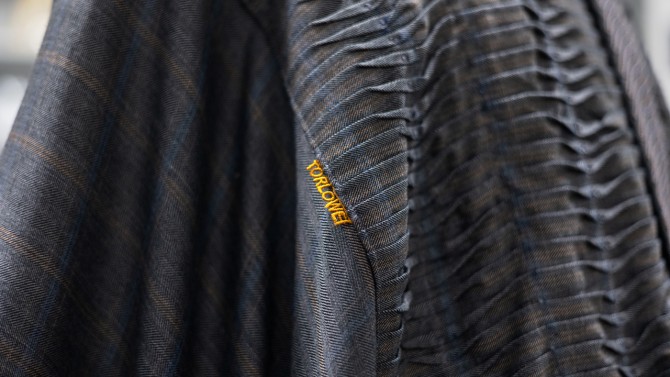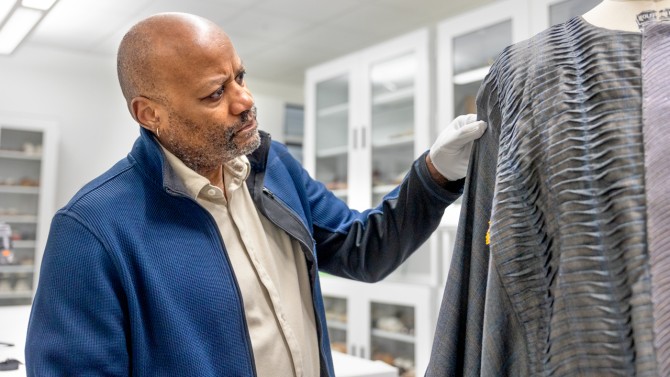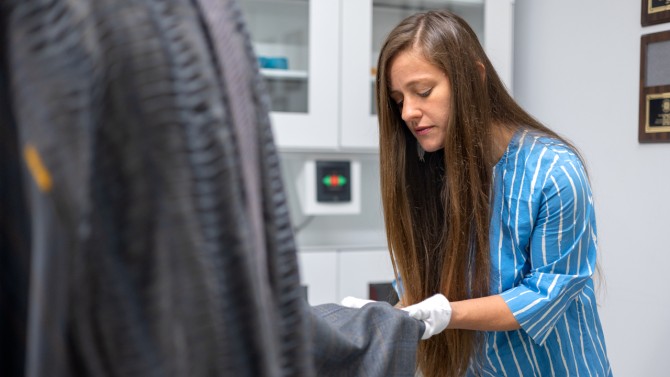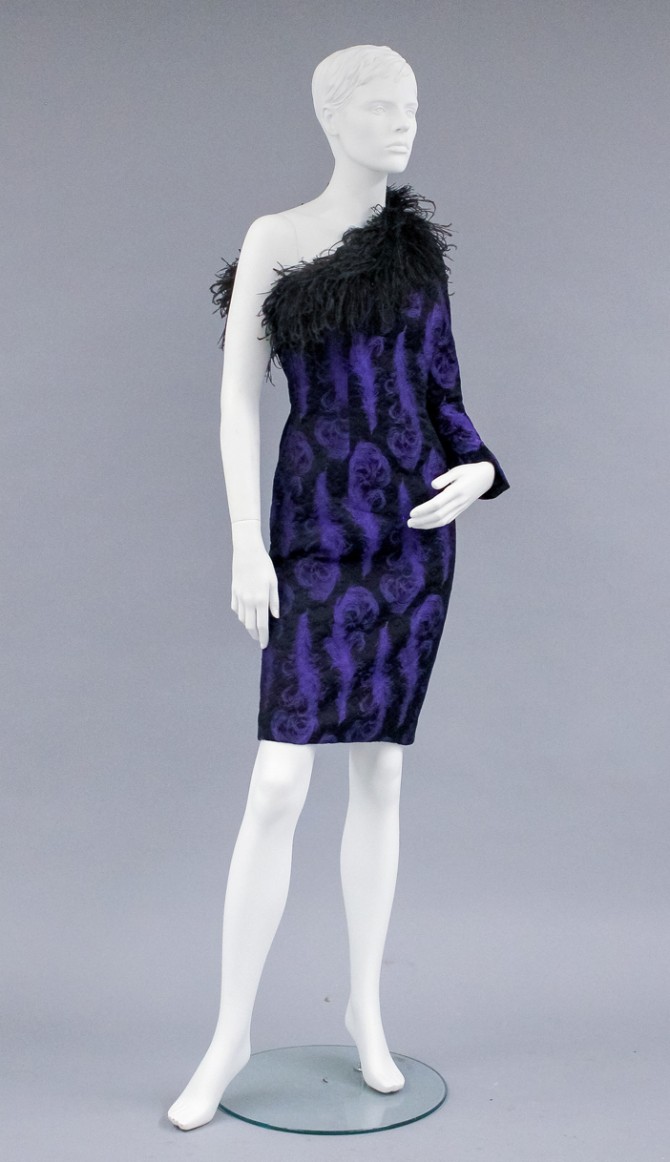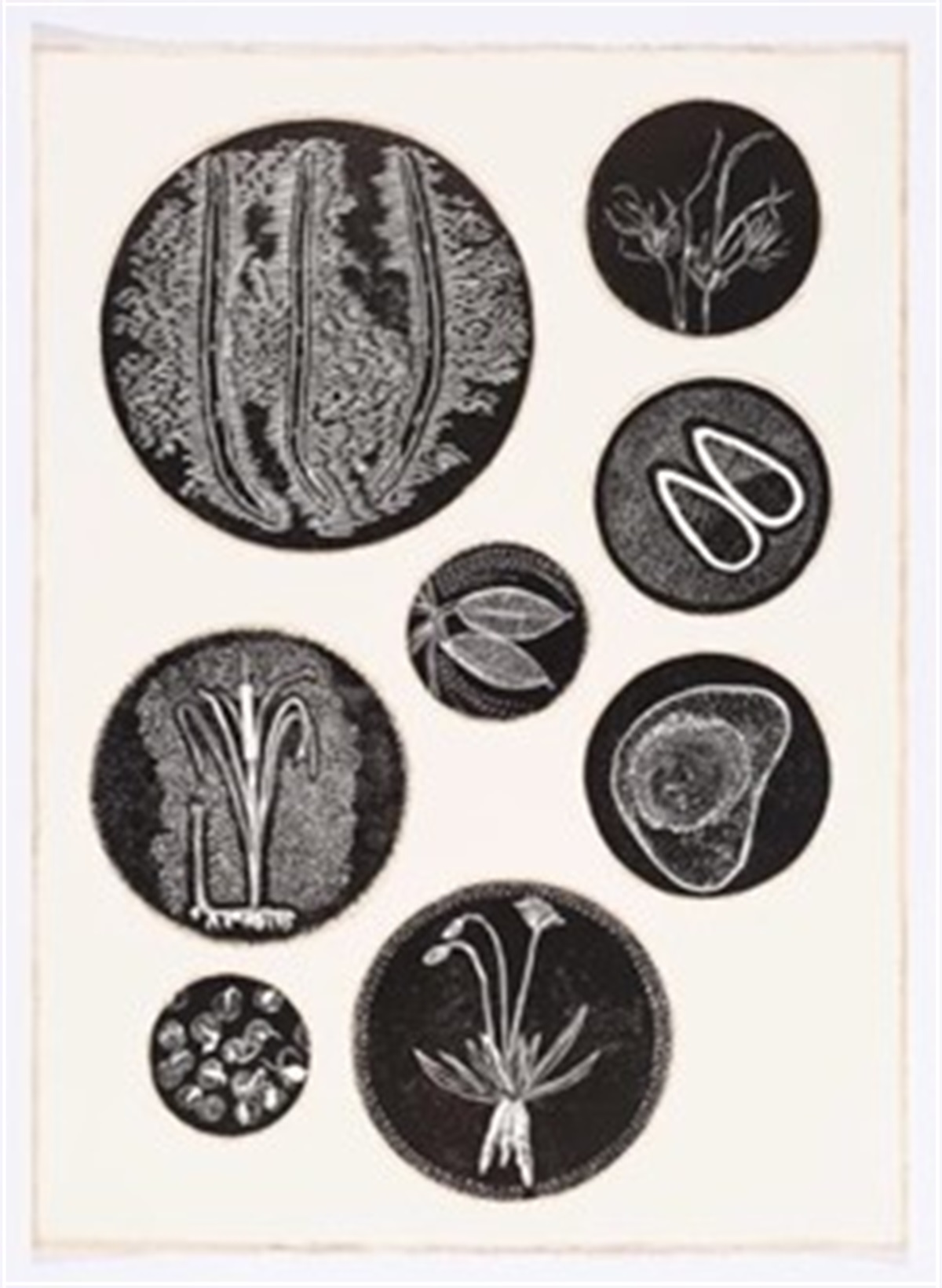In late January, Professor Denise Green and her colleague Catherine Blumenkamp received an email with remarkable news. The auction house Christie’s would be selling off the wardrobe of the famed fashion figure and Vogue editor-at-large André Leon Talley, an influential Black editor at the top of a notoriously white field. Talley had died a year earlier, in January 2022.
“What raced through my mind was, ‘We need to preserve this important history,'” says Green, associate professor of human centered design in the College of Human Ecology (CHE).
Detailing on the front of the caftan displays the name of the designer, Patience Torlowei.
A few weeks later, she successfully bid on a voluminous robe made of gray wool herringbone twill with intricate detailing on the chest. The caftan is the latest of several recent additions to Cornell Fashion + Textile Collection that represent a diversity of cultures – a goal of the collection since its founding in 1915. The piece, not yet on public display, is jointly owned by CHE and Cornell University Library and is housed in the fashion collection.
“It’s a continuation of our efforts to diversify the collection and decenter the Eurocentric narrative that has come to define ‘fashion history,'” says Green, who directs the fashion collection. “We’re expanding and redefining that narrative to become one that’s inclusive of the immense range of fashions worn and made by peoples from across the globe.”
Talley was known for his encyclopedic knowledge of fashion history, his dramatic personal style and for helping dress public figures including Michelle Obama when she was first lady.
“You can’t think about Vogue without thinking about André Leon Talley,” says Dyese Matthews, a doctoral candidate in the field of apparel design. “You can’t think about the Met Gala without André Leon Talley. All these really important staples in fashion culture, he had his hand in it.”
A caftan formerly owned by fashion icon André Leon Talley has inspired students thanks to its rich sociocultural history.
Talley devoured the pages of Vogue as a youngster in segregated Durham, North Carolina. He earned a master’s degree in French literature at Brown University. He began his fashion career by interning for editor-turned-curator Diana Vreeland at the Costume Institute at the Metropolitan Museum of Art. He went on to work as a fashion journalist for Women’s Wear Daily, the New York Times and Ebony and was also creative director at Vogue. He achieved mainstream fame as a judge on “America’s Top Model” and figured prominently in the high-profile documentaries “The September Issue” and “The Gospel According to André.”
He also advocated for more diversity in the industry, such as more Black models on runways and supporting new and non-Western designers.
“He took exception to the exclusionary nature of the fashion industry and expanded definitions of style and beauty. This is someone who was shaping the way we think about fashion and the body, and he really challenged the white, cisgender, young, thin-centric narrative,” Green says. “He did that through journalism as well as his own fashion and style, and actively supported designers who came from historically marginalized communities.”
Green and Blumenkamp, the collection’s associate director, chose to bid on one of Talley’s caftans, majestic robes that became Talley’s signature look in his later years. “A caftan is a long and wide tunic, and does not typically include pants,” Green says. “Not only was Talley confronting prejudices around body size in wearing such a voluminous garment, but he was also defying restrictive sartorial codes for men in the United States. This piece tells all of that story.”
And they wanted a garment that demonstrated Talley’s support of non-Western designers. They narrowed their target down to caftans custom-made for Talley by Patience Torlowei, a Nigerian designer and friend of Talley. Torlowei designs women’s wear and intimate apparel and is known for her commitment to sustainability, ethical production and West African aesthetics. One of her pieces, the “Esther Dress,” was the first couture garment to be acquired by the Smithsonian’s National Museum of African Art.
Green collaborated on the bid with Kofi Acree, curator of Africana collections for Cornell University Library’s Division of Rare and Manuscript Collections.
Kofi Acree, curator of Africana collections for Cornell University Library’s (CUL) Division of Rare and Manuscript Collections and director of the John Henrik Clarke Africana Library, collaborated on the purchase of the caftan now owned jointly by the College of Human Ecology and CUL.
“I really wanted to support Denise’s initiative, because I thought she was right. The purchase speaks to the whole issue about diversity,” says Acree, who is also director of the John Henrik Clarke Africana Library. “It adds to the diversification in terms of designers and adds to the conversation about what these folks do.
“The key thing about it is, she will be using this as an instrument to teach, and to educate students about this person, but also the diversity of the collection.”
Diversifying the collection
Beulah Blackmore had diversity in mind when she created the fashion collection in 1915. As Cornell’s first full-time clothing and textiles faculty member, she began developing the collection as a teaching tool with a focus on non-Western dress. “She wanted to think about fashion and dress as a way of understanding other cultures around the world,” Green says.
In 1936, Blackmore went on sabbatical and travelled around the globe to collect examples of what she called “native costumes” for the collection. As students graduated and traveled, she asked them to send samples back to Cornell.
Denise Green, associate professor of human centered design in the College of Human Ecology, assesses the hem of a caftan designed by Nigerian designer Patience Torlowei.
“She had a very idealistic view – and I think it’s actually true – that if you can help people to understand and appreciate cultural differences, that will reduce fear and therefore create peace,” Green says. In the late 1930s, Blackmore showed these pieces in public exhibitions called “Costumes of Many Lands” at Farm and Home Week, a program of public lectures and demonstrations related to the university’s land grant mission.
Recent additions include a purple cocktail gown with black feathers from the last collection of Patrick Kelly. He was a Black designer who was the first American to be invited to join the Fédération de la Haute Couture et de la Mode (French Federation of Fashion and of Ready-to-Wear Couturiers and Fashion Designers) and show his ready-to-wear collections at Paris Fashion Week, in 1988. “That was a big deal,” Green says.
The collection also has several examples of WilliWear by designer Willi Smith, considered one of the most successful Black designers at the time of his death in 1987. The pieces were donated by David Crandall, J.D. ’87, who wore them on campus in the 1980s. Smith, like Kelly, died of AIDS-related illness.
“Why didn’t these brands continue under new creative direction? Chanel, Dior, Saint Laurent, among other fashion companies, have endured long after the eponymous designer’s death. Others, like Schiaparelli and Balmain, have recently been revived as ‘heritage fashion houses,'” Green says. “Unfortunately, I think HIV stigma and other discriminatory attitudes are a part of why these incredible fashion brands no longer exist. One way of combatting racism and prejudice is by expanding the historical record and archiving the work of designers like Kelly and Smith.”
The collection’s 2021 exhibit “Fashion in Transit” enabled the purchase of a lime-green jumpsuit by Black designer Chesley Taylor, which celebrates Black roller skating culture in the South. Taylor had been sexually harassed in the military and resigned after nine years of service and then started her fashion brand.
There’s a collection of Nepalese textiles and garments and a beadwork bracelet by Indigenous jewelry-maker Suuwayaqawilth, of the Hupacasath First Nation. A donation of West African textiles and clothing from the late 1950s and early 1960s centers on independence movements in Nigeria and Guinea; one is wax printed with the repeated word “non” – “no” in French – advocating against France’s colonial rule. Martha Moore ’82 helped design the collection’s Nike hijab swimsuit. And there’s a TomBoyX gender-neutral swimsuit in rainbow colors.
“We have very limited funds and no designated acquisitions budget, so in any purchase we make, we want to be sure that it can tell a range of stories,” Green says.
‘A poorly sewn hem can ruin a beautiful garment’
In the bright white space of the Cornell Fashion + Textile Collection, Green lifted a sleeve of the caftan draped on a mannequin adjusted to measure 6’6″ – Talley’s height.
In addition to its historical value, this particular caftan was chosen for its merits as a teaching tool to show expertly executed finishing techniques. Rows of tiny pintuck pleats on the chest create the illusion of movement. The tidy flat felled seams are similar to those used on jeans but are tacked down with embroidery rather than straight stitches. And a box pleat at the center back nods to the robe á la française style favored by well-dressed women of the mid-1700s.
Recent additions to the Cornell Fashion + Textile Collection include a purple cocktail gown with black feathers, from the last collection of Patrick Kelly.
“We’re not just teaching fashion history, or cultural studies of dress,” Green says. “We’re also teaching our students how to make garments, design clothes, and how to evaluate quality.”
She recently gave a tour of the garment to Matthews, her advisee.
“Torlowei has actually finished this sleeve by simply folding the fabric in half and combining the two edges about half way up the sleeve into a flat felled seam at the elbow, so you don’t have that awful stitched hem at the wrist,” Green says. “A poorly sewn hem can ruin a beautiful garment.”
They turned to the most notable part of the piece – the elaborate chest placket, dominated by streams of tiny folds, each tacked down with one hand-knotted stitch. “This is called a wave tuck or twisted tuck, because it’s folded back down in alternating directions, and you can do them at different depths to get this dynamic wave-like effect,” Green says.
She also pointed out how the wool herringbone twill demonstrates an innovative use of a fabric typically used to make suits.
“It’s a really great example of different design techniques for students to explore,” says Matthews, whose dissertation looks at how middle-aged Black women in Harlem refer to Harlem’s rich cultural history through their dress.
Another student, Maya Abrol ’24, has already used the caftan as inspiration to learn the pleating technique, which she incorporated into a gold lamé dress she designed for a final project in Blumenkamp’s draping class this spring.
Beyond the technical aspects, the garment has inspired students with its sociocultural history.
“Talley broke a lot of barriers in fashion really unapologetically. So as a Black woman, obviously I look up to him in many ways. And I resonate with a lot of what he has shared in terms of his experiences,” Matthews says. “To have one of his caftans here at the university, I appreciate that, because it’s allowing his story to live on. And it’s really comforting that Cornell sees value in what Talley contributed to the world.”

